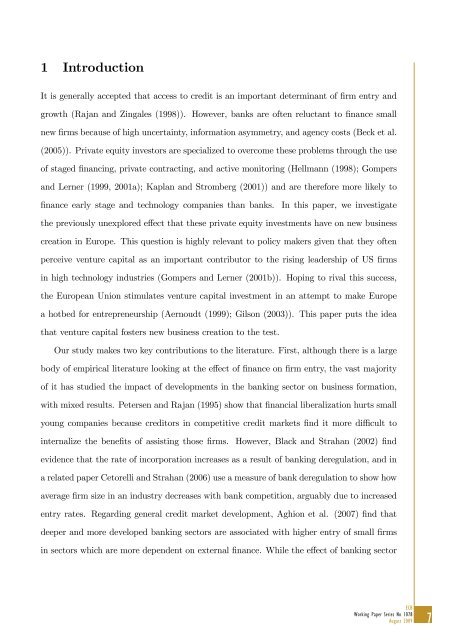On the real effects of private equity investment: evidence from new ...
On the real effects of private equity investment: evidence from new ...
On the real effects of private equity investment: evidence from new ...
- No tags were found...
You also want an ePaper? Increase the reach of your titles
YUMPU automatically turns print PDFs into web optimized ePapers that Google loves.
1 IntroductionIt is generally accepted that access to credit is an important determinant <strong>of</strong> …rm entry andgrowth (Rajan and Zingales (1998)). However, banks are <strong>of</strong>ten reluctant to …nance small<strong>new</strong> …rms because <strong>of</strong> high uncertainty, information asymmetry, and agency costs (Beck et al.(2005)). Private <strong>equity</strong> investors are specialized to overcome <strong>the</strong>se problems through <strong>the</strong> use<strong>of</strong> staged …nancing, <strong>private</strong> contracting, and active monitoring (Hellmann (1998); Gompersand Lerner (1999, 2001a); Kaplan and Stromberg (2001)) and are <strong>the</strong>refore more likely to…nance early stage and technology companies than banks.In this paper, we investigate<strong>the</strong> previously unexplored e¤ect that <strong>the</strong>se <strong>private</strong> <strong>equity</strong> <strong>investment</strong>s have on <strong>new</strong> businesscreation in Europe. This question is highly relevant to policy makers given that <strong>the</strong>y <strong>of</strong>tenperceive venture capital as an important contributor to <strong>the</strong> rising leadership <strong>of</strong> US …rmsin high technology industries (Gompers and Lerner (2001b)). Hoping to rival this success,<strong>the</strong> European Union stimulates venture capital <strong>investment</strong> in an attempt to make Europea hotbed for entrepreneurship (Aernoudt (1999); Gilson (2003)). This paper puts <strong>the</strong> ideathat venture capital fosters <strong>new</strong> business creation to <strong>the</strong> test.Our study makes two key contributions to <strong>the</strong> literature. First, although <strong>the</strong>re is a largebody <strong>of</strong> empirical literature looking at <strong>the</strong> e¤ect <strong>of</strong> …nance on …rm entry, <strong>the</strong> vast majority<strong>of</strong> it has studied <strong>the</strong> impact <strong>of</strong> developments in <strong>the</strong> banking sector on business formation,with mixed results. Petersen and Rajan (1995) show that …nancial liberalization hurts smallyoung companies because creditors in competitive credit markets …nd it more di¢ cult tointernalize <strong>the</strong> bene…ts <strong>of</strong> assisting those …rms. However, Black and Strahan (2002) …nd<strong>evidence</strong> that <strong>the</strong> rate <strong>of</strong> incorporation increases as a result <strong>of</strong> banking deregulation, and ina related paper Cetorelli and Strahan (2006) use a measure <strong>of</strong> bank deregulation to show howaverage …rm size in an industry decreases with bank competition, arguably due to increasedentry rates. Regarding general credit market development, Aghion et al. (2007) …nd thatdeeper and more developed banking sectors are associated with higher entry <strong>of</strong> small …rmsin sectors which are more dependent on external …nance. While <strong>the</strong> e¤ect <strong>of</strong> banking sectorECBWorking Paper Series No 1078August 20097















